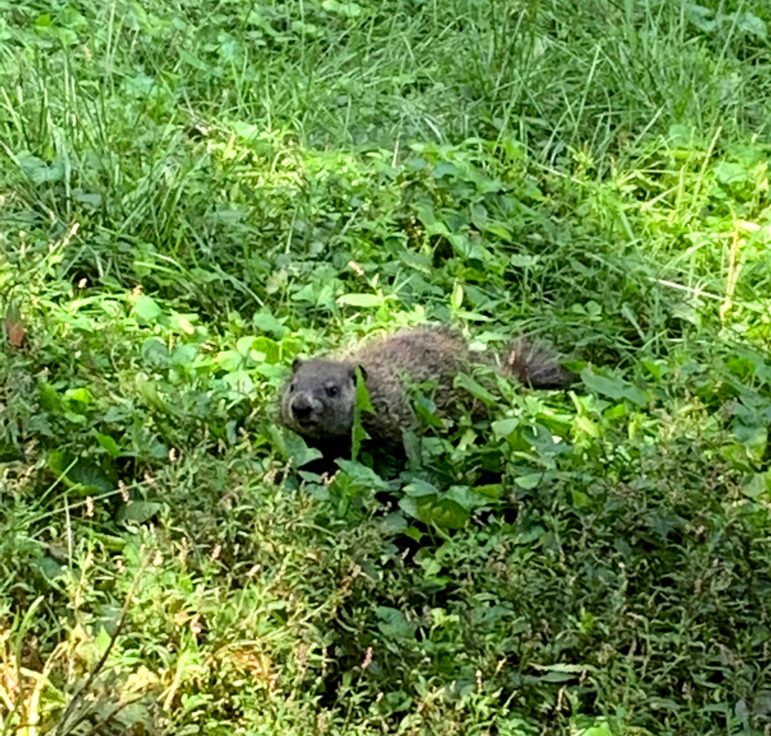
Author’s note: This column contains a brief description of violence toward an animal.
I live across the street from a church, a little outpost of the United Church of Christ with a bell tower made of red brick and a faded blue door. I have never been inside of the church – the closest I have come was during the first few weeks we lived here when we could not figure out the trash pickup schedule and I had to dart into their parking lot to dump my garbage in their dumpster in the dead of night. All I know about the congregation is what I see on their bright electronic sign, which shines all through the night with notices about concerts in the congregation hall and reminders of the Sunday service.
I say that I live across the street from the church, but that’s not quite accurate – I live across from the churchyard, a broad green lot that stands between the bell tower and the next house on our block. And it is in the churchyard that my favorite denizen of the neighborhood lives, underneath a hedgerow abutting the neighbor’s house: the holy marmot, sanctus monax monacum, St. Groundhog.

A young groundhog in a field of clover [Ladycamera, Wikimedia Commons, CC BY-SA 4.0]
“Oh, watch out for him,” many people have told me when I begin to tell the tale of St. Groundhog. “Those things will get in your yard, eat all your flowers, and dig up the whole lawn.” And it is true that, on occasion, my wife will notice that someone has eaten a bunch of her coneflowers, and we have observed that someone has dug up a space between a few loose bricks to squeeze under the fence to gain access to the back yard and its variety of tasty shade plants.
We do not know who might have done these things. All of the evidence is circumstantial. But it must be said that on several occasions a certain beatified rodent has been spotted toddling through the yard with a number of stalks and leaves protruding from his mouth, and this does raise a certain amount of suspicion.
Still, even if St. Groundhog does eat the occasional flower, there is no doubt that it is a small price for his company. As a crepuscular saint, he is often active around the time I get home from work in the evening. I look for him in the churchyard as I park my car, and many evenings I spy him there, munching on his clover.
Sometimes he stops in place when he hears me and stands upright, as though waiting to see if I am a predator about to chase him into his nest; sometimes he dives into his home beneath the hedge before I even get out of the car. And then I wonder what a groundhog thinks about an automobile, which must seem to be a loud and smelly and unyielding sort of megafauna, and I cannot blame him for choosing to hide. But some nights he simply watches me, and I watch him. We say good evening to one another and then carry on our way. It is a simple ritual, but one that brings me a childlike joy that is in short supply these days.
I asked my wife if she knew of a word for this relationship – a steady kinship with a specific wild animal. Not a pet, not an animal in the zoo, but a particular creature we meet in our regular lives again and again and come to know, to the degree possible, as a friend and companion. I know this is likely not a common bond, at least not in the modern industrial world; I will encounter birds or squirrels every day, yes, but generally not one specific bird or one particular squirrel again and again. But that is the relationship my wife and I have with St. Groundhog.
We could not think of a name for it, other than anthropomorphic metaphors like “neighbor,” which is a pity. As a Pagan, it is a lovely kind of connection, a reminder that humans are not so divorced from the rest of nature as we are led to think.

St. Groundhog, on pilgrimage in the author’s backyard [Photo Credit: E. Scott]
One night a few weeks ago, I came home from work later than normal, after the sun had already set. As I drove down the street perpendicular to my block, I saw something in the road. To my horror, I realized that it was an animal that had been hit by a car – and as I got closer, the distinctive shape of a groundhog’s head came into view under the sodium lights. I felt an urge to stop the car and gather the animal’s remains, though in honesty I had no idea what I would have done with them if I had. I turned down my street and parked in front of the churchyard, and quietly looked toward the hedgerow to see if there were any sign of movement. There was not.
Even as I walked in the door, I felt there was something a bit ridiculous about my grief. A groundhog only lives a few years in the wild anyway, and any animal that lives on the ground in the city is likely to be hit by our 3,000-pound vehicle. (One of the main advantages a tree squirrel has over its ground-dwelling cousin is that there are no cars up there.) Death is a part of life, we tell ourselves again and again; this was no different. But as I told my wife what I saw, I nearly cried, and wished again that I had a word to describe what I had lost.
The churchyard was quiet for the next week. When I arrived home after work, I still stopped to look, but it was increasingly clear there was no point in it. Groundhogs are solitary animals, and the groundhog I had seen was only a block up the road – it was almost certainly still within the territory of a single marmot. My work, which involves public education, got very busy as the new school year began, and the fate of the groundhog slipped from my mind.
On another late work night earlier this week, my wife sent me a text message. “St. Groundhog just ran into the backyard!” she wrote. Later she sent a photograph of a marmot slinking through the clover in the churchyard, hale and whole as ever. I broke out grinning in the middle of my meeting, glad that my face was covered by a mask.
There are many explanations for the apparent resurrection of St. Groundhog: there could be several groundhogs in the area, and one of them could have found his hole and claimed it, or could have been the groundhog who was hit by the car while our groundhog slumbered in the summer heat. We had seen St. Groundhog with another marmot earlier in the summer, possibly a child, and perhaps that groundhog had taken up the spot in the churchyard.
These are all likely possibilities. Whatever the truth is, I am just happy to have my marmot back in the churchyard, apparently risen from the dead. It is a small miracle to see him at the close of day – but then, he is only a very small saint.
The Wild Hunt is not responsible for links to external content.
To join a conversation on this post:
Visit our The Wild Hunt subreddit! Point your favorite browser to https://www.reddit.com/r/The_Wild_Hunt_News/, then click “JOIN”. Make sure to click the bell, too, to be notified of new articles posted to our subreddit.

Pingback: Bone Songs Chronicle for September 12, 2021 – Alexis Kennedy